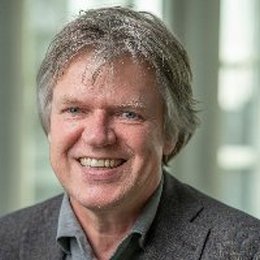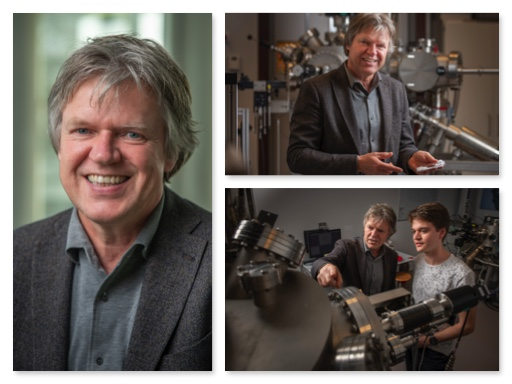Guus Rijnders plays lego with atoms
‘If you want new technologies, you first need new properties in materials.’ Guus Rijnders, professor in NanoElectronic Materials, searches for these new properties – and develops new complex materials, mainly for application in electronics. ‘We are now able to communicate via computers and smart phones, all of which are made of materials. For future development and more advanced, more sustainable technology, we need new types of materials. How do we find those? By playing lego with atoms. Everything is made of atoms and we can play around with their types and order, which is what essentially creates the materials’ properties. That is what I do. Through both fundamental and applied research, I look for new properties that could be used in various devices.’
Professor Rijnders points out that material science is central to the world’s development. ‘We have always applied materials to work for us. That is why we even name eras based on materials. There was the Bronze Age, Iron Age, now we live in what could be called the silicon era. We need new materials which we can use in electronics, sensors and batteries to move forward, like materials that are able to learn.’ That is another exciting topic that the scientist is exploring. ‘I have begun researching the use of artificial intelligence (AI) in materials, also called neuromorphic computing. We are taking brain as a model system and aim to mimic brain activity in a new type of material, which would lead to electronics that consume a lot less energy and are smarter, able to learn. With such materials, we could simply say ‘here are your basic properties, adapt yourself based on the stimuli and feedback from the environment’. This could mean a huge leap for various electronics, starting with computers, mobile phones and autonomous cars. Self-driving cars have a lot of electronics on board, but nowadays electronics would consume about 30-40% of the power of an electric car, which is a lot. With neuromorphic computing, energy consumption would be significantly lower.’ Rijnders is already involved in a European project focused on this topic, developing a smart camera that uses neuromorphic computing and is able to learn.
If we want the world to be more sustainable, we need to consume less energy. For that, we need good storage facilities, but the technology we have right now will never get there. That is why I stop and ask questions such as: what do we need to make the perfect battery? A battery that could potentially power big aeroplanes and all our cars? With current technology, we can forget about such an innovation. We need a breakthrough. And it all begins with the right materials.’ Materials with high power density, which could mean a huge jump forward for the aforementioned batteries, are one of the research lines Guus Rijnders is focusing on nowadays.
Although his work is largely fundamental, Guus Rijnders always has real-life applications in mind. ‘We do a lot of fundamental research without any specific application as a goal, but very often we use the state of the art technology we develop for applied work. On many projects, I collaborate with companies, such as Canon, IBM or spin-offs of the UT. What drives me the most is curiosity-driven research, but the end goal is always making the world a bit better.’
Research and education
Education is still a major part of the researcher’s activities. ‘The main objective we have as a university is educating people. And while educating people, you also have a lot of hands available. With my students, I see myself more as a sparring partner. I like that we can team up and do innovative and creative research.’ Guus Rijnders teaches material science, which – as he says – ‘is not an easy subject’. ‘I try to teach students that theory and experimental work always go hand in hand. I usually start with visualizing the topic. I tell them things such as ‘imagine that you are an atom. If you move around, how does it influence the material?’ I want to give them a feeling of how it actually works. A material scientist needs to understand how to directly apply theory in practice.’
With his teaching, Rijnders contributes to the Molecules & Materials master track of Chemical Engineering, as well as the graduate programme “Physics and Chemistry of Novel Materials for Nanoscience and Nanotechnology”. He has developed courses on Advanced Materials as well as Advanced Characterization in the master track Chemical Engineering, Applied Physics and Nanotechnology.
About Guus Rijnders
Guus Rijnders is a Professor in NanoElectronic Materials at the Inorganic Materials Science group of the UT. He is also the Scientific Director of MESA+ Institute for Nanotechnology. The journey to these positions wasn’t traditional. Rijnders first studied at a university of applied sciences and began his career at the UT in 1988 as a research engineer. After that, he got the opportunity to take education courses and in 2001 he got a PhD degree at the UT, embarking onto a scientific career, which led to a full professorship in 2010.
PRESS PHOTOS
These Press Photos can be used with no copyright restrictions


